
A Willie Wiredhand bobblehead seems to be bowing his head and shining the light of a bulb bearing his likeness on a variety of rural electrification memorabilia and electric consumer products. The items are part of an online museum Electric Consumer staff is assembling for the magazine’s 65th anniversary this month and for the 65th anniversary of mascot Willie Wiredhand.
“Your Indiana electric cooperative companion” turns 65 years old this month. But “retirement” is nowhere in sight! Rather, Electric Consumer staff hopes readers are still enjoying the publication’s 2013 upgrade to a magazine after being a newsprint tabloid all of its previous years (which began in 1951 as Indiana Rural News).
In the past year, Electric Consumer launched a new and improved website and has begun work on a pilot project with several subscribing REMCs around the state for an electronic version that can be read and shared on mobile devices. The new electronic version will be for consumers who prefer receiving their news and information electronically.
These new ways of reaching out to readers reflect a new vision Electric Consumer publisher, Indiana Electric Cooperatives, and local co-ops are developing for the future. Safe, affordable and reliable electricity, obviously, remains the number one priority of cooperatives. But as IEC CEO Tom VanParis notes in his column this month, a whole new world of opportunities await co-ops wanting to further improve the lives of consumers through the rural and suburban communities cooperatives serve.
As co-ops look forward, this month’s top story takes a nostalgic and sometimes whimsical look back on the history of electric co-ops covered in the pages of this publication. In addition, that history was shared by iconic co-op mascot Willie Wiredhand, who also celebrates his 65th anniversary this year. Willie was adopted by the National Rural Electric Cooperative Association directors as the mascot in February 1951.
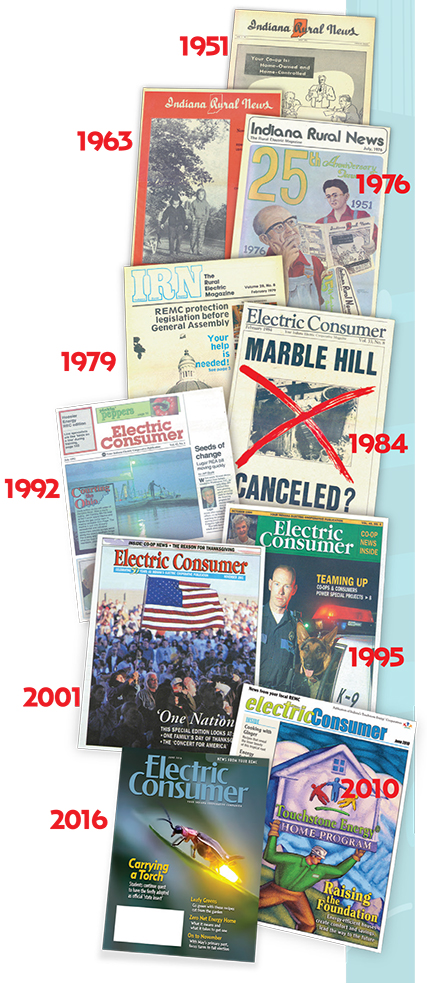 After the print issue of the July 2016 issue goes the way of the recycling bin, Electric Consumer intends to have its 65th anniversary legacy live on in a “virtual museum” of rural electrification that staff hopes to have posted by the end of summer. With the anniversary issue, we assembled just a few of the many items we’ll have online for folks to view. In 2014, we asked readers to share images for the online museum and gallery of rural electrification memorabilia, art and artifacts.
After the print issue of the July 2016 issue goes the way of the recycling bin, Electric Consumer intends to have its 65th anniversary legacy live on in a “virtual museum” of rural electrification that staff hopes to have posted by the end of summer. With the anniversary issue, we assembled just a few of the many items we’ll have online for folks to view. In 2014, we asked readers to share images for the online museum and gallery of rural electrification memorabilia, art and artifacts.
Some of you responded, sending images of old appliances and REMC memorabilia you have hung onto or inherited. We also will toss in items Electric Consumer staff has gathered. Electric co-ops — as organizations created and still owned and operated for and by their consumers — have a unique history. We need to continue to remind new consumers about this past and celebrate it, even as we move onto new challenges and opportunities.
Here’s a sneak peek at “Willie Wiredhand’s Virtual Museum and Gallery of Rural Electrification Memorabilia, Art and Artifacts (and some fiction)”!
Richard G. Biever is senior editor of Electric Consumer.
From a bobblehead come bright ideas!

![]() Willie Wiredhand Bobblehead,
Willie Wiredhand Bobblehead,
circa 2004
This 7.5-inch tall bobblehead of electric cooperative mascot Willie Wiredhand was distributed by the National Rural Electric Cooperative Association and its marketing partner, Summit Marketing, beginning in the early 2000s. The bobblehead, photographed and animated using computer software, became a staple of Electric Consumer’s safety and marketing messages geared mostly for younger consumers. The bobblehead sold out and is now a collector’s item.
![]() Sylvania 75-Watt Willie Wiredhand LightBulb, circa 1958
Sylvania 75-Watt Willie Wiredhand LightBulb, circa 1958
In the late 1950s, Sylvania Electric Products Lighting Division teamed up with NRECA to produce a Willie Wiredhand lighting campaign. The incandescent bulbs, etched with an image of Willie and individually packed in Willie-adorned cardboard sleeves, were offered for sale at cooperative offices or were given away to consumers during annual meetings, 4-H fairs, appliance demonstrations and the like. Bulbs were available in 75-, 100- and 150-watt sizes. The bulb in the Electric Consumer’s virtual online museum, carefully cradled by the bobblehead, was purchased on eBay in the mid 2000s for $30.
The seller was a retired employee with Public Service Indiana who found it, still in its original sleeve, in a drawer-full of miscellaneous odds and ends he and his wife bought at an estate auction near Terre Haute, he said. Recognizing the special electric co-op etching, he said he figured someone would be interested in it. Electric Consumer considers the now almost 60-year-old bulb the “holy grail” of its collection of Willie and rural electrification memorabilia.
The advertising page behind it — marking the beginning of the campaign — is a reproduction from a late 1950s issue of Rural Electrification Magazine, the national trade publication for electric co-ops.
Co-op home building programs . . . chips off the old block
Indiana’s Touchstone Energy Home Program is mentioned frequently in Electric Consumer. The building/remodeling program provides high standards of materials and practices to produce homes that are significantly more energy efficient than homes built to typical standards. While this all-inclusive program, which includes heating/cooling/ventilation/water heating systems and the home’s entire envelope of materials, methods, insulation, etc., began in 2004, co-ops have always helped consumers get the most value and comfort for their energy dollar. (Visit www.itehome.com for info on the Touchstone Energy Home.)
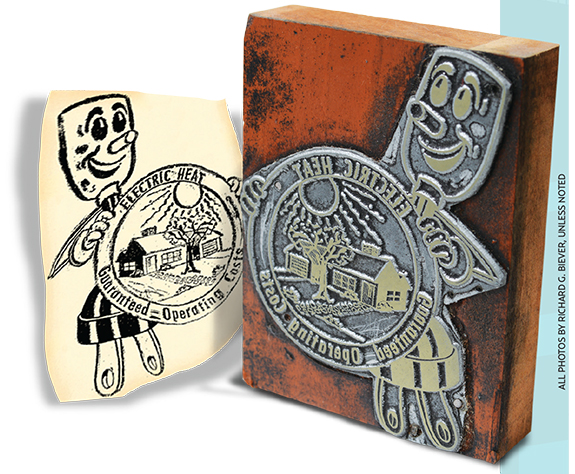
![]() Metal on Wood Letterpress Printer Block,
Metal on Wood Letterpress Printer Block,
circa 1960s/70s
This raised reversed image of Willie Wiredhand holding an emblem for an “Electric Heat” home was from a marketing campaign used by co-ops to encourage electric heating. The letterpress block was from when printers still made up pages setting text with raised single block letters and art to make positive impressions of ink on paper.
The block was found among the fire-damaged remains of a print shop Miami-Cass REMC had used.
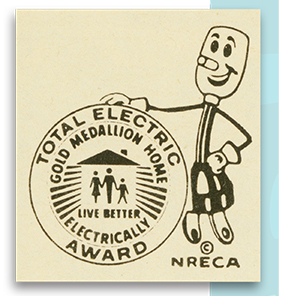
![]() Total Electric Gold Medallion Home Award, Indiana Rural News, August 1968
Total Electric Gold Medallion Home Award, Indiana Rural News, August 1968
Just as printing methods drastically changed in the past 40-50 years, so too have energy strategies and construction technology. This ad, from a 1968, promoted a Gold Medallion home program co-ops initiated for remodeling and new construction, a forerunner to today’s TE Home Program.
Ask not what your co-op can do for you . . .
Electric cooperatives were built from the ground up by their consumers. With few power companies willing to extend electric lines into sparsely populated rural areas in the 1930s, farmers and rural residents went door to door signing up neighbors to start their own electric co-op to supply themselves power. The federal government aided the movement by establishing the Rural Electrification Administration to provide loans and support. Thus began both the nation’s most successful public/private partnership — the rural electrification of America — and co-op involvement in politics.
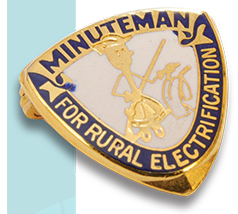
![]() Minuteman for Rural Electrification Lapel Pin,
Minuteman for Rural Electrification Lapel Pin,
late 1950s/early 1960s
One of the first organized efforts by the nation’s electric cooperatives to enlist consumers to fight for co-op interests was called “Minutemen for Rural Electrification.” Its logo was mascot Willie Wiredhand in the guise of a Colonial Minuteman. Those who agreed to be part of the program could be asked to engage lawmakers at a moment’s notice over legislation that could affect electric co-ops. Volunteers received this pin.
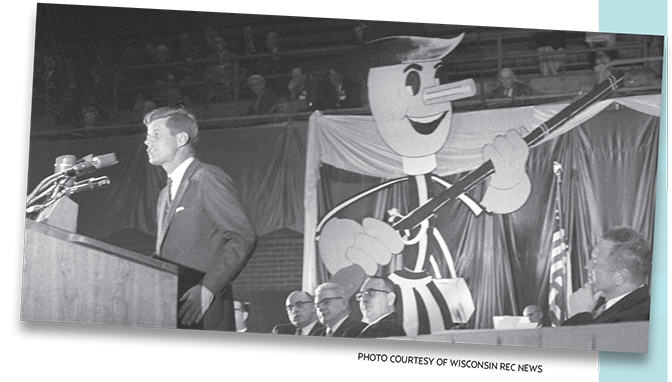
![]() John F. Kennedy
John F. Kennedy
“Minuteman” Photo, 1959
In 1959, John F. Kennedy, then a senator from Massachusetts, the place where the original Revolutionary War minuteman group was formed, spoke to the national electric co-op gathering in Washington. Behind him was a banner of Willie as a Minuteman. Kennedy went on to win the 1960 presidential election. His administration maintained close ties with co-ops.
To learn more about what you can do politically for your co-op during these politically charged days, please visit Action.IndianaEC.org.
There was an app-liance for that …
While electrical appliances have continually evolved and improved with added technology and safety and convenience features since electric co-ops first brought electricity to rural Indiana in the mid-1930s, the basic function they provide to make our lives easier or more comfortable hasn’t changed. Here are several “vintage” items, either submitted by readers or that Electric Consumer staff members have inherited from parents and grandparents. If you have an old electrical item you’d like to add to our virtual museum for display online, email a photo and whatever you know about it to ec@indianaec.org.

![]() Capitol Products Chrome & Black Metal Flip Toaster, circa 1935
Capitol Products Chrome & Black Metal Flip Toaster, circa 1935
Today’s rushed, multi-tasking breakfast makers might find it hard to believe, but before toasters automatically toasted both sides of your bread at the same time to your pre-selected liking and popped out the slice when ready, toasters required a bit of manual labor and trial and error to find the preferred toasting time. With this flip toaster, you’d drop down the side (this one features a door on each side to do two slices at the same time), lay your bread slice on the door, close it and wait. Then, you’d open the door again to have the bread flip over and repeat to toast the other side.
![]() General Electric Bakelite Musaphonic Radio, circa 1940s
General Electric Bakelite Musaphonic Radio, circa 1940s
After World War II, sales boomed for electric consumer products that were mass produced with the help of new materials like Bakelite, a brittle, dark brown plastic. This radio was submitted by Judy Grindle, a Kosciusko REMC consumer from Syracuse who wrote: “This was my parents’ radio from the early 1940s. As a very young child, I remember my father listening to the grain and livestock reports. It is in excellent working condition and has the original tube. I acquired it about 10 years ago, and it will be passed down to family. Listening to it brings back memories.”
![]() Westinghouse Electric Oscillating Desk Fan, circa 1950
Westinghouse Electric Oscillating Desk Fan, circa 1950
This one-speed oscillating desk fan can still conjure up a breeze as well as a strong sense of nostalgia. Surprisingly, the 12-inch blade is plastic. Though the wideness of the circular wire cage surrounding the blade certainly tempted curious minds to see if safety screens and mesh on modern fans is really needed, we decided keeping all our fingers available for typing this text made more sense. We’ll just assume it was probably a wise design decision to reduce access to moving fan blades.
![]() Toastmaster Bakelite & Chrome Toaster, circa 1950
Toastmaster Bakelite & Chrome Toaster, circa 1950
This wedding-gift classic features a lightness/darkness setting and two slots. Its rounded chrome design is classic; in fact, can it really be considered “vintage” if so many toasters still copy its form today? If not for the advent of these spring loaded/popping workhorses, entire generations of youngsters might have grown up eating “Flip-Tarts” instead of “Pop-Tarts” (see earlier toaster at far left).
![]() Rival Ice-O-Matic Electric Ice Crusher, circa late 1950s-early 1960s
Rival Ice-O-Matic Electric Ice Crusher, circa late 1950s-early 1960s
Before manufacturers started putting automatic ice dispensers (cubed or crushed) in the doors of refrigerators, folks wanting crushed ice on a hot summer day had work to do. They had to break cubes loose from the ice trays in the freezer and use a hinged, handheld metal crushing device (which resembled something used in the Spanish Inquisition). Drop the cubes in the cupped side and squeeze the crusher down on top … never easy.
Or, beginning in the 1950s, you could plug in your handy “Ice-O-Matic” right there on the countertop. You turned on the motor and let it rev up to speed for a second or two. Then, you dialed in the desired coarseness of the ice you wanted crushing. Finally, you slid in your cubes one at a time through a little door on the front. Metal blades inside would crush the ice and drop it into a handy drawer you’d pull out at the bottom.
![]() Tudor Tru-Action Electric Football, circa 1970
Tudor Tru-Action Electric Football, circa 1970
While not technically an “appliance,” a football gridiron reduced to the size of a large griddle, then electrified, deserves a place in our virtual museum. Certainly not as iconic or as beloved as various scaled electric train sets, electric football was on most every American boy’s Christmas list from the 1950s well into the 1970s (before video games came along). The game is notorious for requiring minutes of quiet tedious set up alternating with seconds of noisy chaos.
To play, two players would carefully align their 11 plastic football players in formations along the line of scrimmage. Then, one would flip the switch. As the field vibrated, the offensive and defensive players would move forward and collide. But just as often as not, players hooked arms and danced circles or visited the sidelines. Traditionally, the rules called for a game of “touch” — the ball carrier holding a tiny felt football was considered down when his base was touched by an opposing player. But we know rambunctious adolescents created a tackle version by cranking up the speed control. This caused the players to bounce, jar and jolt across the field. The ball carrier was not down until he literally was knocked over by an equally off-balanced opposing player or fell over and was touched.
Electric football now enjoys a cult-like following of adult hobbyists around the country who have developed regional leagues and have custom built players (and even coaches). They play on custom-made table-like fields up to 6 feet long and even have a national championship.
Watt’s cookin’?
The reader recipe page has always been a mainstay of Electric Consumer. Each month, readers submit gobs of recipes to match a given theme. One of the highlights of the month around our office is the day staff prepares the chosen recipes for the next issue, photographs the food, and then — and here’s the best part — gets to sample it!
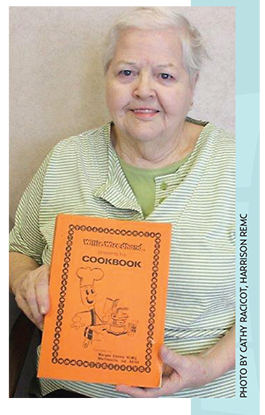
![]() Willie Wiredhand Cookbook, mid-1970s
Willie Wiredhand Cookbook, mid-1970s
Printed originally by Morgan County REMC (now South Central Indiana REMC) in 1974, the book was reprinted multiple times. In 1978, Harrison REMC consumers Jacqueline Armstrong and her husband bought a new electric range from a local appliance store. Along with the warranty papers inside was an ordering form for the cookbook by the Martinsville-based REMC. She ordered one and liked it so much that she ordered another 10 for other cooks in the family. When her mother, Anna Deckard, passed away at 100 years and 1 day last year, Armstrong donated the book she had used to Harrison REMC where it’s displayed with other co-op memorabilia.

![]() “Red Hot Willie” Sauces: High Voltage (JalapeÑo) Sauce and Lightning (Cayenne) Sauce, circa mid-2000s
“Red Hot Willie” Sauces: High Voltage (JalapeÑo) Sauce and Lightning (Cayenne) Sauce, circa mid-2000s
An employee of the Electric Cooperatives of Arkansas gained nationwide notice among co-ops several years ago when he combined his love of making hot sauce and his love of Willie Wiredhand to promote electric co-ops. The back of the green jalapeño label is peppered with facts about the Arkansas electric co-ops. On the back of the red are the “Seven Guiding Principles” all cooperative businesses adhere to.
Being true to this school would have been no sweat
Electric co-ops take an active role in their communities; it’s one of those Seven Guiding Principles you’ll find on the back of the Red Hot Willie Lightning Sauce above. Part of that support is sponsoring local athletic programs, especially for youth. But here’s one school that wore its feelings for its local electric cooperative on its sleeve — for just doing what it does.
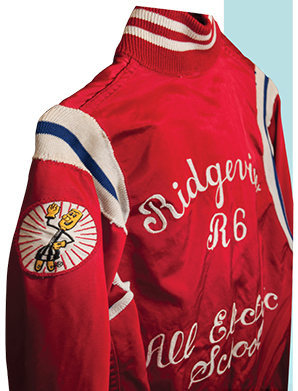
![]() Ridgeview “All Electric School” Willie Wiredhand Basketball Warm Up Jacket, 1965
Ridgeview “All Electric School” Willie Wiredhand Basketball Warm Up Jacket, 1965
Carroll White REMC consumer Roy Patrick sent this “old school” basketball jacket to Electric Consumer years ago. He said he picked it up when he lived in southern Missouri in the 1970s. The grade school, Ridgeview, was closing through consolidation. Equipment and uniforms were being sold off cheap. He said he was always intrigued by the embroidered “All Electric School” on the back of the jacket and the Willie Wiredhand patch, the kind worn by co-op lineworkers, on the sleeve. The school, he noted, fed into a high school with the nickname “Zizzers” that used a bolt of electricity in its logo. But that didn’t seem to sufficiently explain the co-op connection.
When U.S. Rep. Jo Ann Emerson of Missouri became CEO of the National Rural Electric Cooperative Association in 2013, the district she served and stepped down from happened to include that school district. When told about the curiosity, she asked a former aide there to check it out. Turns out, it was just the local electric co-op and school proudly marketing the school’s “all electric” status.
Take 40 winks with Willie
A Willie Wiredhand brand of electric blankets was also marketed by co-ops to consumers in the early/mid- 1960s.

![]() Willie Wiredhand Electric Blanket, 1965
Willie Wiredhand Electric Blanket, 1965
Willie Wiredhand’s parts may be a bundle of brass and wires, but his electric blanket was “down-soft,” “moth proof and mildew free,” came with dual controls and a full 2-year guarantee. The blankets were produced by Statewide Rural Electric Cooperative Corporation, a service company of Kentucky’s electric cooperatives in Louisville in the 1960s. The blankets came in three sizes and four decorator colors: Blue Mist, Sand Beige, Elfin Green and Carioca Rose. The box was purchased at an auction and donated to Jasper County REMC by a consumer. The marketing sample beside it was discovered in the Jasper County REMC’s files. Both are on display at its Rensselaer office.
See you in the funny pages
Along with a regular cartoon strip that touted the benefits of electricity in Indiana Rural News in the late 1950s, Willie Wiredhand also starred in his own comic books.
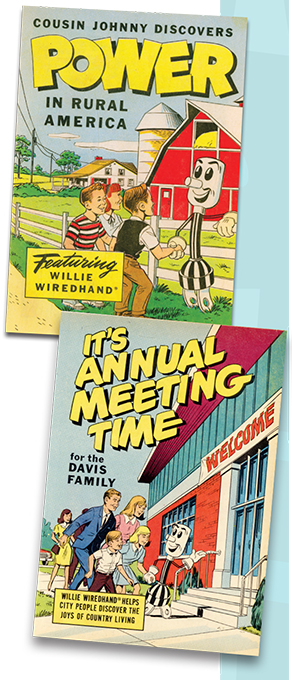
![]() “Cousin Johnny Discovers Power in Rural America,” 1967
“Cousin Johnny Discovers Power in Rural America,” 1967
Produced by Cranfill Advertising Agency in Indianapolis, by permission of NRECA, Willie explains to city boy Johnny, visiting his aunt, uncle and cousins on the farm, the history and benefits of rural electrification.
Cranfill Advertising is now Three Sixty Group in downtown Indianapolis.
![]() “It’s Annual Meeting Time for the Davis Family,” 1968
“It’s Annual Meeting Time for the Davis Family,” 1968
In a sequel to “Cousin Johnny,” Willie “helps city people discover the joys of country living” as he introduces them to all the 1968 modern conveniences of an electric home on rural electric cooperative power lines … and shows them what a consumer-owned electric utility is all about.
Both comics were distributed by co-ops across the nation. Both books can be read in full on our website:
 REMC:
REMC:
‘Ringing
Everyone
a Merry
Christmas’
Over the years, Electric Consumer and Indiana’s electric cooperatives have actively tried to play a small part in creating glowing memories during the year-end holidays. Two of our favorite groups of items in our virtual museum come from Christmas. From 1964 through 1970, participating REMCs around the state gave away 45 rpm Christmas records. From 1996 to 2005, Electric Consumer held a Christmas tree ornament contest for readers. After a 10-year hiatus, the ornament contest returns this coming December.
![]() Christmas Ornament Contest, 1996-2005
Christmas Ornament Contest, 1996-2005
Beginning with the December 1996 issue, Electric Consumer presented winners of its annual Christmas Ornament Contest. Each autumn, readers sent us amazingly beautiful, whimsical and reverent handcrafted ornaments. These would be voted upon at our office and awarded prizes. Then during the Indiana Electric Cooperatives’ annual meeting, held usually in early December, where co-op directors, managers, staff and spouses from all over the state would gather, we would hold a silent auction for the ornaments. The money raised was given to the Ronald McDonald House of Indiana in Indianapolis. Usually, a Willie Wiredhand ornament or two always arrived, much to the delight of co-op folks! Here are three that appeared on Electric Consumer covers.
Go to our YouTube video of all past winners.
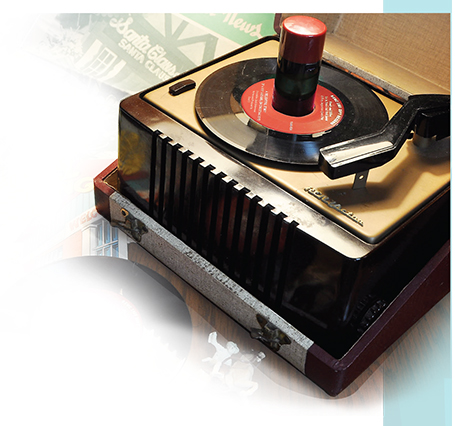
![]() REMC Gift Records, 1964-1968, 1970
REMC Gift Records, 1964-1968, 1970
Beginning in 1964, Indiana’s electric co-ops commissioned a series of 45 rpm records that were given out as Christmas gifts to consumers. They told of horse-drawn sleigh rides, of Santa’s reindeer and elves, and of electricity. They all ended with a catchy jingle: “Ring, ring, ring, ring, R-E-M-C, ringing everyone a ‘Merry Christmas.’”
Electric Consumer digitally recorded these records, with ticks and all, and posted them on our YouTube channel. Check them all out:
1964/1967: Ringing Everyone a Merry Christmas
1965: Decorating the Outdoor Christmas Tree
1966: Side A — Asking Santa a very important question
1966: Side B — Santa’s reindeer surprise Randy and Ellen
1968: Side A — A mysterious visitor surprises Timmy and Ellen
1968: Side B — Timmy and Ellen help their new friend solve his problem
1970: Side A — A wonderful invention solves Santa’s problem … almost
1970: Side B — Santa leaves the ‘Best Christmas Present Ever’
Willie Wiredhand sings the “Ringing Everyone A Merry Christmas” chorus
COVER BOY: WILLIE WIREDHAND GROWS UP WITH ELECTRIC CONSUMER
![]() Both Willie Wiredhand and Electric Consumer began service in 1951. Willie has appeared frequently on the cover over the years, here are some of our favorites:
Both Willie Wiredhand and Electric Consumer began service in 1951. Willie has appeared frequently on the cover over the years, here are some of our favorites:




